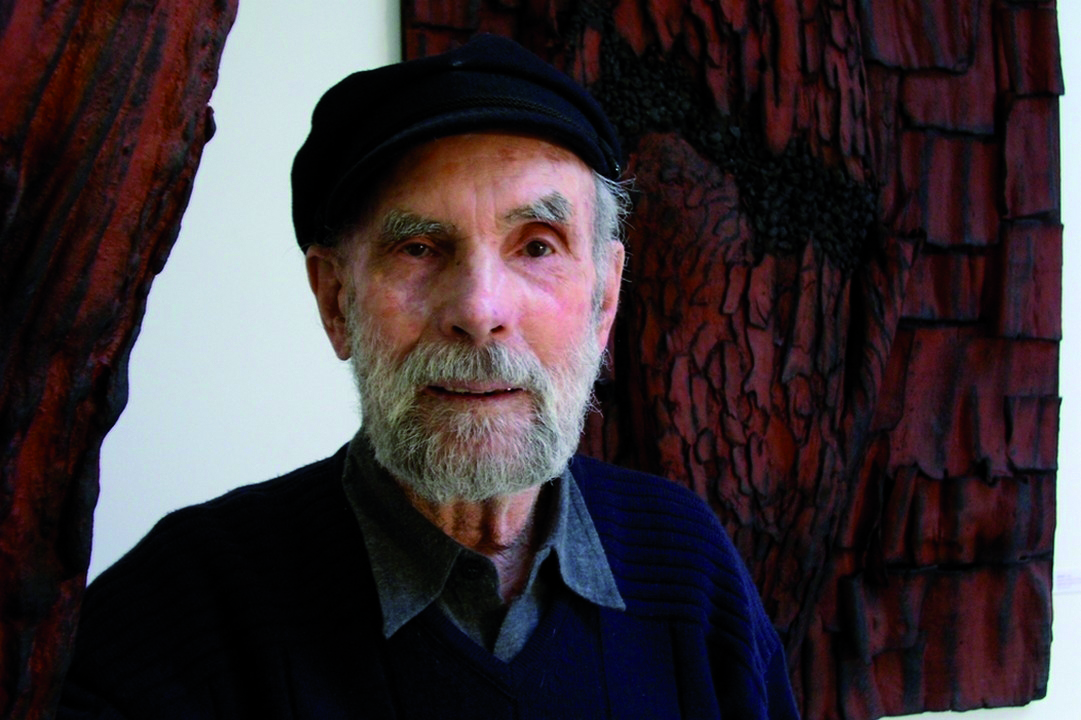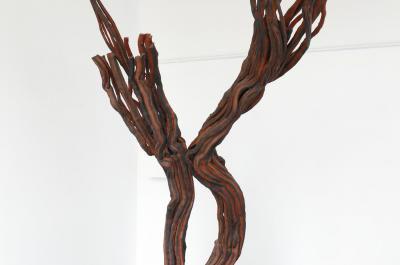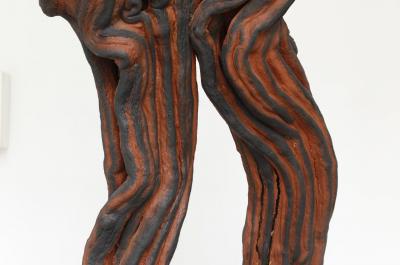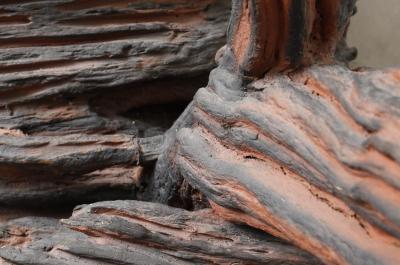"Cour des Jardiniers" Galleries
J. Frans Krajcberg
"La révolte III", tribute exhibition
published at 12/02/2018
Frans Krajcberg, an ardent champion of ecological art, died in 2017. The Domain of Chaumont-sur-Loire was duty bound to pay tribute to an artist so fully committed to the defence of nature by exhibiting one of his works.

Sculptor, painter and photographer Frans Krajcberg was born in Poland in 1921. After a string of adventures connected with the Second World War and following a short stay in Paris, he arrived in Brazil in 1947 and set to work tirelessly in the Amazonian forest, turning burnt trees into artworks. He committed himself to fighting a double battle, both artistic and ecological, against those who were bent on destroying nature. He was the voice of Brazil’s ecological conscience.
His discovery of the Amazonian forest set him irrevocably on his life path, bringing him face to face with the “great impact of nature”. And nature was to be his primary source of inspiration, soon to become the very meaning of an art that fought relentlessly in its defence. His realisation that the forest was being destroyed by fire in order to meet the needs of agriculture and that the Indians were being dispossessed of their lands as a result was a turning point. It was not long before all his work was being carried out in direct proximity with nature: whether it is his paintings making use of vegetable components, his pigments – natural produce of Brazilian soil – or his sculptures created from charred wood salvaged from the burnt-out forests, Frans Krajcberg’s art lies at the very heart of his relationship with nature and the affronts it suffers with each passing day. (Un artiste en résistance - Claude Mollard and Sylvie Depondt)
His monumental sculptures are created from wood that “survived’ Amazonian forest fires: trees ravaged by fire, interlaced clumps of creepers, multicoloured palm-tree trunks and calcined bark.
According to the artist’s long-time friend Pierre Restany, “their truth is that of the nature from which they sprang so directly, and that very nature is calling out to our culture for a return to its moral order”.
Krajcberg’s art would seem to have committed him to an endless quest, whose goal it was to bring what is dead back to life. “I was born of the world that is called nature and the great impact of nature; it was in Brazil that it happened. I was born a second time there.” “My works are my manifesto. Fire is death, the abyss. Fire has always been with me. Destruction has shapes. I seek out images for my cry of revolt.”
“Art was created for the marketplace, not to accompany the reality of the world and humankind’s evolution. I do not seek to create art, I seek to express myself and cry out, for I am a rebel. People should now see how Amazonia is being destroyed, how its destruction is permitted… They are in the process of making Amazonia disappear. It is the remains of Amazonia that I show.”
BIOGRAPHICAL NOTES
Frans KRAJCBERG
POLAND

1921
Frans Krajcberg is born in Kozienice, Poland, the third of five children in a Jewish family of shopkeepers. His mother, Bina Krajcberg, is a national leader of the Polish Communist party and is frequently imprisoned. He spends much of his childhood with his uncle. He joins the Communist Youth organisation at the age of 13.
1939-1945
His mother is hanged in Ramdam prison near Warsaw on the day war is declared. He returns to Kozienice but finds no trace of his family. He is imprisoned in a church but escapes with a number of other Poles and joins the Red Army. While in Vilnius, he meets Anilewich, the future leader of the Warsaw Ghetto Uprising. He falls ill and is hospitalised in Minsk, where he takes up painting during his convalescence. He enrols at Leningrad’s School of Fine Arts and studies Hydraulic Engineering at the same time. He meets his first great love, Natacha, who is killed before his eyes on the road to Minsk, while they are hiding in the forest trying to escape the bombs. In 1941, the Reich attacks the USSR. He joins the First Polish Army and is sent to Tashkent in Central Asia, where he is made technical supervisor of Uzbekistan’s dams. In 1943, he joins the Polish Second Army as an officer assigned to bridge-building. He becomes Marshal Joukov’s pontonier and is the first soldier to enter liberated Warsaw.
1945-1946
His family has been murdered in the Holocaust. He throws the two medals awarded to him by Stalin over the Czechoslovakian border. He travels to Stuttgart, where he tries one last time to find any surviving members of his family, but without success. He studies at the city’s School of Fine Arts under Willi Baumeister, who had been a teacher at the Bauhaus.
1947
He is drawn to Paris. Armed with a recommendation from Baumeister, he meets Marc Chagall through Fernand Léger, who puts him up for three months and organises his departure for Brazil. He sets sail with the collusion of a young Hungarian girl who pretends to be his fiancée but leaves him to his own devices as soon as they arrive. In Rio, he has no money to live on and sleeps on Botafogo Beach.
1948-51
Francisco Matarazzo has opened São Paulo’s Museum of Modern Art. Taken on as a warehouseman, Krajcberg is soon to be found in the company of the Familia Artistica Paulista group’s “self-taught painters”, including Mario Zanini, Volpi and Cordeiro. He is put in charge of installing the museum’s First Biennale, which highlights Max Bill, leading light of Brazil’s concrete art movement. He takes himself off to the coastal village of Itanhaem, where he settles down to paint undisturbed in a house belonging to Mario Zanini, who joins him there regularly along with Volpi. His works are exhibited at the Museum of Modern Art but none of them are sold.
1952-1956
He comes into contact with Brazilian nature for the first time in Porto Alegre, in the State of Paraná. He is employed to monitor forest protection. He goes off into the forest by himself to paint and create handcrafted items, including pottery, azulejos (glazed tiles), statuettes, still lifes and plants. In 1955 he can no longer bear seeing Paraná’s forests go up in smoke. His own house in the forest is destroyed in a fire. He returns to Rio where he shares a studio with Franz Weissmann and paints Samanbaias (ferns), reminiscences of Paraná. He holds a joint exhibition with Milton Dacosta and Maria Leontina at the Petite Galerie.
1957
The São Paulo Biennale is devoted to Pollock. Krajcberg wins the “Best Brazilian Painter” prize. Suddenly famous, he sells his canvases and returns to Paris. Henceforth he divides his life between France and Brazil.
1958
He is granted Brazilian nationality, but criticism in his adopted country remains harsh. In Brazil, he produces his first sculptures in the State of Minas Gerais. In Paris, he takes an active part in the intellectual and artistic debate that raged during the late 1950s: the Algerian War, the School of Paris crisis and polemics around Abstraction. He stops painting, “poisoned” by the turpentine used as an oil-paint thinner, and creates collages and woodblock prints on Japanese paper. He produces his first “direct woodprints” using the moulded paper technique.
1959
In Ibiza, he starts photographing nature. He produces his first “prints of rocks and earth” and paintings using natural components. He meets the critic Pierre Restany, who writes Nature est son atelier (Nature is his Studio). Direct prints, assemblages and scenographic treatments… he is a marginal precursor of Arte Povera and Land Art. He visits Amazonia for the first time.
1960-1961
On his return to Paris, he exhibits his works at the XXème Siècle Gallery and meets Michèle, with whom he lives for four years. Dubuffet, whom he admires, appreciates his use of natural materials and Braque takes a liking to him. He rubs shoulders with the New Realism avant-garde and takes an interest in Op Art and Kinetic Art. He is made an honorary citizen of Rio de Janeiro and awarded the keys to the city, and San Lazzaro, Director of the XXème Siècle Gallery and periodical, hosts his Reliefs exhibition. He makes friends with the photographer/reporter Roger Pic, who lives in the alleyway now known as Chemin de Montparnasse. He makes his second trip to Amazonia.
1964
The Venice Biennale highlights his “paintings of earth and stones”. He is invited to Minas Gerais, returns to Brazil and settles in Cata Branca, where the iron-ore fields provide him with pure pigments. He produces his first sculptures and macrophotographs where mixtures of earth and glue are applied to paper, dried in the sun and then reworked.
1965-1966
Zanini tells him about Nova Viçosa, where a multidisciplinary project is bringing together such artists and intellectuals as the architect Niemeyer and the singer Chico Buarque de Hollanda. Enthralled by the forest and seashore, he builds his first studio, designed by Zanini, and settles there.
1967-1970
He takes his vision of Minas back to Paris with him, setting aside his paintings of stones and starting on his “Cutout Shadows”, dyed assemblages of natural wood (creepers and mangrove roots) on which the light plays. He marries Alba, a young Brazilian from Bahia, the daughter of wealthy Salvadorian physicians. She is studying Art History and writes a thesis on Kandinsky. The couple separate three years later.
1972-1974
In Nova Viçosa, he creates his first “polished wood” sculptures, assemblages of dead wood which he endows with architectural lines: hollow trees and mangroves, consumed by light. He designs a treehouse for himself, flanked by a sculpture, Mémoire à la Destruction (Memento of Destruction). Facing the ocean, he photographs his sculptures on the sand in order to capture both shadow and light. His “sand prints”, mouldings made directly on the beach at low tide, become white paper reliefs reworked with natural pigments. He travels across Minas Gerais and Piauí in Pierre Restany’s company.
1975:
In Paris, the debate aroused by his exhibition at the yet to be completed Georges Pompidou National Art and Culture Centre strengthens his resolve to defend nature under threat. It is the first exhibition to be held under the “Centre Pompidou” banner. The future building is still under construction. He meets Claude Mollard, Centre Pompidou’s Secretary General.
1976-1978
He leaves for Mato Grosso in Amazonia with Sepp Baendereck, whom he had met the previous year. They share the same passion for the defence of nature and remain bound by their cause until Baendereck’s death in 1989. They go on three Amazonian expeditions together (1976-77-78) and three trips to Mato Grosso (1985-86-87). In 1978, Pierre Restany sails up the Rio Negro with them. During the journey, he writes his Manifeste du Naturalisme Intégral or Manifeste du Rio Negro (Manifesto of Integral Naturalism / Rio Negro Manifesto), in which he explores his own vision of art confronted with Krajcberg’s “alternative” aesthetic. He is backed up by a film screened during the debates held in Rio, São Paulo and Brasília during the launch of the Manifesto, which arouses considerable controversy.
1979-1984
Moving to Nova Viçosa, he starts on his polychrome vegetable prints. He sets aside his “Cutout Shadows” to concentrate on monumental “plaited wickerwork” sculptures inspired by local craftwork. He assembles bits and pieces of nature in order to bring them back to life.
1985-1987
In Mato Grosso, he produces a lengthy photographic report on the “queimadas” – the forest fires that major landowners resort to in order to clear their land. He collects dried-out palm trees, using them to create various sets of sculptures, his “conjuntos": rainsticks and totems, which he groups together into forests of their own. He publishes his book of photographs Natura. He starts on his “burnt wood” sculptures.
1988-1995
In Seoul, he takes part in a symposium on the environment with Images de mes Révoltes (Images of my Revolt). His “burnt wood” works are steles, alarm sirens. In Romania, he joins with other artists to participate in the “Doctors without Borders” movement. He is invited to the International Ecology Congress in Moscow. It is the first time he has returned to Russia since he was a student at Leningrad’s School of Fine Arts. His “burnt bark” sculptures, set off by with natural materials, echo his “burnt wood” works. In Rio, he exhibits Imagens do Fogo (Images of Fire) at the Museum of Modern Art, alongside the United Nations Conference on Environment and Development (UNCED). In Rio Branco, in the State of Acre, he photographs the devastated forest and salvages scattered remnants to use in his sculptures. He tries to persuade farmers to stop felling trees. He is threatened and only just escapes with his life on several occasions. The Curitiba City Hall and Paraná’s Government dedicate a “Cultural Space” to him, raising a monolith in his name. He meets the Cacique Amerindian Raoni and commits himself to defence of the Amazonian Amerindian cause.
1996
In Paris, the Villette-Amazone exhibition, held at the Grande Halle de la Villette under the aegis of Jacques Leenhardt and Bettina Laville and nothing less than a manifesto for the environment, includes several of his works.
1997-2003
He helps his friend Roger Pic save the Passage du Montparnasse, a place of memory for many 20th-century artists. He persuades him to donate some of his works to the City of Paris. Roger Pic dies in 2001. Pierre Restany, who has become Vice-President of the Montparnasse Museum Association, which includes occupants of the Passage, dies in 2003. The Art et Révolte exhibition held in the new Montparnasse Museum pays tribute to his work. Several places are named after him. He donates sculptures to the City of Paris and they are put on exhibition in a former gallery now called “Espace Krajcberg”. Located just a few metres away from his own studio, it becomes a special reserve that he shares with his 10-hectare forest in Nova Viçosa. In Paraná, a museum named after him is inaugurated in Curitiba’s botanical gardens. In Nova Viçosa, he busies himself with construction of the buildings accommodating his “Art and Nature” Foundation and publishes the second edition of his book Nature et Révolte.
2005-2007
Back in Paris, it is Brazil Year in France. The City of Paris holds a major exhibition in the Parc de Bagatelle, celebrating the 100th anniversary of its acquisition of the park. Dialogues avec la Nature pays tribute to Krajcberg as both artist and activist. Franco-Brazilian debates on the role of urban and periurban forests are organised. Paris, Rio and São Paulo take an active part in them and they provide him with an opportunity to issue his Cri pour la Planète (Cry for the Planet). A bronze sculpture is set up in Place de la Vache Noire in Arcueil. His work is included in the Entre Deux Lumières – artistes brésiliens en France (Between Two Lights – Brazilian Artists in France) exhibition at the Brazilian Embassy.
2008-2012
Bahia makes him a “Bahiano Citizen”. With Government support, he publishes a book of photographs on deforestation entitled Queimadas His works are included in the O Grito – Ano Mundial da árvore (Rallying Cry – World Tree Year) exhibition at the Palacete Das Artes Rodin. He exhibits in São Paulo’s Ibirapuera Park and is awarded the prize for Best Exhibition of the Year by the Art Critics Association and honoured with the title of “Paulistano Citizen”. In Gifu in Japan, he is awarded the Enku Prize for Sculpture. In João Pessoa, his work is included in the Natureza Extrema (Extreme Nature) exhibition inaugurating the Estação Cabo Branco Museum. In Paris, he is awarded the City’s Vermeil Medal in recognition of his life’s work.
2016
He is guest artist of honour at the 32nd São Paulo Biennale.
2016-2017
In Paris, the Museum of Mankind exhibits his works in an artistic itinerary that takes in all its recently reconfigured permanent exhibition galleries. Meetings and discussions on his work are organised. Espace Krajcberg hosts performances and work by the Museum’s researchers.


